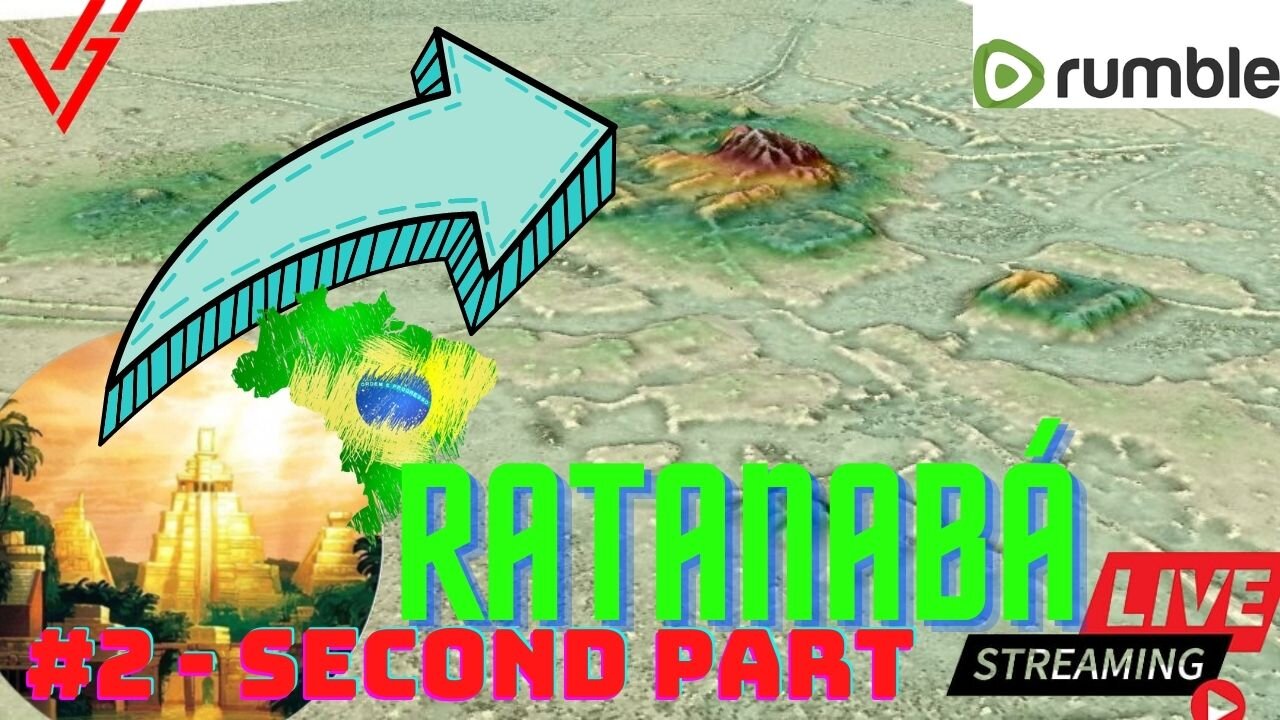Premium Only Content

#2 - second part, Ratanabá: 'lost city in the Amazon' makes no sense
00:00 - #2 - second part, Ratanabá: 'lost city in the Amazon' makes no sense
00:07 - 1 - What may be behind the interest in the topic:
Neves, who has no profile on social media, confesses that he had never heard of Ratanabá until the second week of June 2022.
“When they started asking me about it, I even went to research and consult other colleagues who study Amazonian archeology, but no one knew about this story”, he says.
Although there are profiles on social networks and even books published about this “lost civilization” in recent years, the topic has only gained popular interest and has become a widely discussed subject in recent days.
In Neves’ assessment, the phenomenon can be explained by a series of factors.
“It seems to me a mixture of the naivety of people, who want to believe in this type of thing, with economic interests in exploring the Amazon”, speculates the specialist, who remembers other similar legends, such as the city of Eldorado, a target of explorers throughout the centuries for supposedly being made of gold.
“And we cannot ignore racism in this context either. When you say that there were ‘advanced’ civilizations 300 million years ago, you are taking from the ancestral peoples, who are the ancestors of today’s indigenous peoples, the authorship of all those constructions”, adds.
“It’s something similar to what we see in the book ‘Were the Gods Astronauts?’, by Erich von Däniken. There, it sounds easier to explain that the pyramids of Egypt were built by extraterrestrial beings than to give credit to African peoples”, he compares.
“And all this denotes a deep racism with all non-European populations, such as indigenous peoples and Africans, as if they were not capable”, he interprets.
Finally, the archaeologist opines that the fact that legends of the type are gaining steam just now serves as a kind of test balloon.
“They act as a smokescreen at a time when we have two people missing and divert attention from the real problem of violence in the Amazon”, he adds.
02:04 - 2 - stones in the way:
“In general, the Amazon has few rocks. So, the main raw material used in the constructions of the past was earth and wood”, he contextualizes.
“To understand these periods, we need a multidisciplinary team, capable of working with objects that were left behind and withstood time, such as ceramics, organic remains, soil samples, pieces of food, seeds and bones”, he exemplifies.
To illustrate this difficulty, Neves cites as an example an article published a few weeks ago in the scientific journal nature by experts from British and German universities.
The research revealed the details of two large archaeological sites measuring 147 and 315 hectares (an area equivalent to 205 and 441 football fields, respectively), including the existence of pyramids, in the Bolivian Amazon.
“These earth structures have been known for 60 years, but it was very difficult to define whether they were natural or were built by humans,” says the archaeologist.
“It was only possible to get this answer now, because we have a technology called Lidar capable of doing this type of analysis.”
03:17 - 3 - The future depends on the past:
But, after all, given the scientific evidence available at the moment, what do scientists know about the history of the people who inhabited this region?
“We know that the Amazon was densely occupied in the past and that the people who lived there left very visible marks of the way of life they had, with geometric ditches and linear roads”, summarizes Neves.
“And we have data that show us very securely a direct relationship between the individuals who made these constructions in the past and the indigenous peoples of today.”
“It is not, therefore, a question of a lost civilization, which disappeared millions of years ago”, assures the researcher.
According to the Scientific Panel for the Amazon, a publication coordinated by the United Nations (UN) that has a chapter on the peoples who lived in the region before the arrival of Europeans, there is evidence that this tropical forest has been occupied by indigenous people for 12 years. a thousand years.
“During this long history, indigenous societies developed technologies that were highly adapted to local conditions and optimized for the expansion of the food production system,” writes the group of experts who signed the document, led by Neves.
“Amazon archeology shows how deep the indigenous history is in the region, characterized by cultural and agro-biological diversity. It is one of the few independent centers of plant domestication on the planet and one of the first centers of ceramics production in the New World” , follows the text.
“All these technologies can inspire new forms of urbanism, waste management and integrated land use systems”, conclude the authors.
For Neves, this set of evidence allows seeing the Amazon as a “biocultural heritage”, with an interaction between human action and nature over millennia.
“Therefore, to protect the Amazon, we need to strengthen local populations, such as indigenous peoples, riverside dwellers, quilombolas and caboclos, because they play a very important role in the construction and maintenance of this biocultural heritage”, concludes the archaeologist.
Research: Vitor hugo Lizardi Leonardi
About my channel of curiosities, this channel is to see and hear curiosities of our world in general, if possible leave your like and subscribe to have new notifications about new subjects, thank you very much
Come meet me, and give your opinion about the channel, for me it's very important!
—— ?? TALK TO ME.
Research: Vitor hugo Lizardi Leonardi
facebook: facebook.com/vitor.leonardi
instagran: instagram.com/vitorleonardi/
twitter: twitter.com/vitorleonardi
email: vitorleonardi99gmail.com
Music credit: Slave Chidrean's Crusade
Performed: John Williams
Composer: John Williams
Produced: John Williams, Bruce Botnick
Source: Wald Disney Records
Good reading ,The 7 Habits of Highly Effective People
https://www.amazon.com.br/Habits-Highly-Effective-People-Powerful/dp/1982137274/ref=asc_df_1982137274/?tag=googleshopp00-20&linkCode=df0&hvadid=379726347250&hvpos=&hvnetw=g&hvrand=6784634493429849819&hvpone=&hvptwo=&hvqmt=&hvdev=c&hvdvcmdl=&hvlocint=&hvlocphy=20104&hvtargid=pla-908915591470&psc=1
Hello friends, If you liked it, don't forget to LIKE and SUBSCRIBE to the channel, strengthen our work, it's very important, to expand the channel. I'll tell you, thank you
The channel was created to promote texts and sounds for us to think a little about life and how we can be very happy with the little we have, liked it, leave your LIKE, your comment as soon as possible, we will respond, thank you.
I'm a writer, I'm working on this project!
contact we will respond within 48 hours email: vitorleonardi99@gmail.com
#second part Ratanabá,#lost city in the Amazon,#lost city,#Amazon,#it doesn't make sense,#interest in the topic,#Ratanabá,#social networks,#had never heard of Ratanabá,#study Amazonian archeology,#nobody knew about this history,#lost civilization,#popular interest,#broadly subject,#phenomenon can be explained by a number of factors,#mixture of people's naivete,#belief in this kind of thing,#archaeologist,#economic interests in exploring the Amazon,# city of Eldorado,#made of ,#gold,# pyramids of Egypt,# credit to African peoples,# non-European populations,#indigenous and Africans,#vitorleonardi,
-
 LIVE
LIVE
Trumpet Daily
18 minutes agoTrumpet Daily LIVE | Aug. 26, 2025
103 watching -
 34:31
34:31
Rethinking the Dollar
50 minutes agoWednesday Morning Check-In: Let's Talk...
16 -
 LIVE
LIVE
The Big Mig™
3 hours agoViolence & Burning The U.S. Flag, Democrats New Battle Cry
5,226 watching -
 LIVE
LIVE
The State of Freedom
3 hours ago#327 Digging Deeper into the Carbon Capture Scam w/ Brad LeBlanc
47 watching -
 38:39
38:39
VINCE
3 hours agoThis Is How The Media Spins The News | Episode 111 - 08/26/25
112K58 -
 LIVE
LIVE
Badlands Media
8 hours agoBadlands Daily: August 26, 2025
3,740 watching -
 LIVE
LIVE
GritsGG
3 hours agoWin Streaking! Coloring Hair at End of Stream! Most Wins 3435+ 🧠
103 watching -
 1:56:45
1:56:45
Dear America
3 hours agoNO MORE BURNING FLAGS!! 🇺🇸 Trump Signs Order Making It ILLEGAL!! + Trump Is SUING NEWSOM!
90.9K59 -
 LIVE
LIVE
JuicyJohns
3 hours ago $1.10 earned🟢#1 REBIRTH PLAYER 10.2+ KD🟢
115 watching -
 1:56:23
1:56:23
Law&Crime
3 hours ago $0.97 earnedLIVE: Adelson Matriarch Murder Trial — FL v. Donna Adelson — Day 3
21.3K